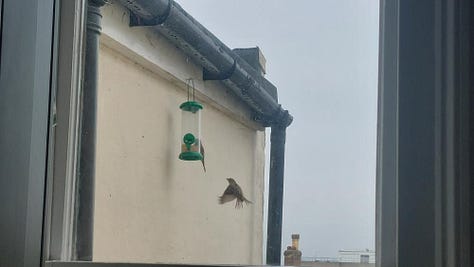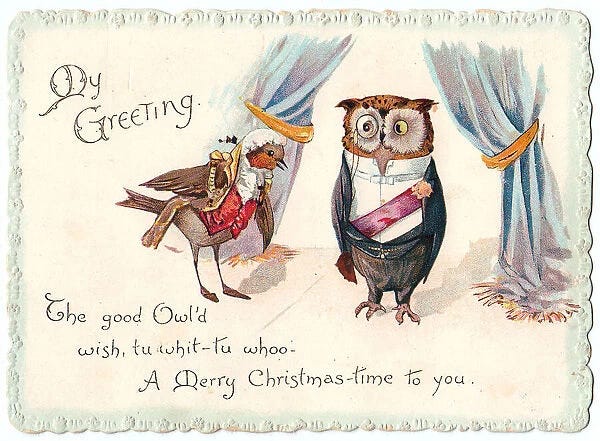Happy Day!
And a warm welcome from Hathersage, where it is delightfully drizzly.
For those of you new around these parts, welcome 👋 My name is David and I’m a writer, outdoor instructor, cyclist-at-large with Thighs of Steel and Expeditions Manager at British Exploring Society.
In this newsletter, I write stories that help you and me understand the world (and ourselves) a little better.
Sometimes I feed the birds.
The Fall of the House Sparrow
Last Saturday, we bought a bird feeder.
I am now obsessed.



They’ve got through about three whole feeders’ worth in five days, with the rate of dispatch accelerating as more of the neighbourhood catches wind of the new buffet in town.
So far, I’ve seen one Pigeon, one Robin and possibly a Blackcap — but I don’t really know what I’m talking about, since the bulk of my bird ID skills come directly from the images printed on Christmas cards.
The first to arrive at our hanging feast were House Sparrows, who had a short commute from their favourite Rowan (?) tree.
Apparently, Crystal Palace was once famous for its sparrows. There’s even a pub named after their most charismatic predator: The Sparrowhawk.
But the urban population of House Sparrows declined by 60 percent between the 1970s and early 2000s, with the steepest decline in London and East Anglia.

The decline has been alarming enough for the 6 million breeding pairs of House Sparrows to be added to the UK’s Birds of Conservation Concern Red List.
(Side note: New entries to the Red List in 2021 included Greenfinch, Swift and House Martin, but there was better news for rising populations of White-tailed Eagle, Song Thrush and Kingfisher.)
Nobody fully understands why Sparrow numbers have fallen so sharply — but it’s probably something to do with humans. (When is it not?)
House Sparrows have always had a close relationship to humans — indeed, bar isolated cases, they simply won’t breed away from us. They earn their bread and butter by pecking at the fringes of our carelessness, ill-hygeine and miscellaneous littering.
For example, Sparrow numbers took a tumble in the early twentieth century with the disappearance of horse-drawn carts and the general cleaning up of our streets. Nothing screams biodiversity like a big horse poo in the middle of the road.
But the reasons behind the vertiginous House Sparrow decline since the 1970s are more fiddly to pin down.
Perhaps it’s the intensification of agriculture and ‘tidying up’ of farms. Perhaps it’s breeding performance (come on, guys!) Perhaps it’s improved sanitation and rubbish collection. Perhaps it’s the electromagnetic pollution of our mobile phone networks (finally — a 5G conspiracy supported by actual science).
Perhaps it’s predation by Evil. You know who I’m talking about.

But maybe — PLOT TWIST — maybe it’s us, with our bird feeders, creating an intra- and inter-species feeding frenzy that pushes populations into close quarters, helping to spread parasites, such as the Trichomonas gallinae that causes ‘lesions that interfere with the ability to swallow, leading to regurgitation, starvation and mortality’.
Oops.
I suspect Our Clever Little House Sparrows (as they’re now known) have figured out a way of dumping a whole batch of seed from the feeder onto the neighbour’s roof below.
Often, there is more seed outside the feeder than inside.
That way, rather than sharing the feeder, two at a time, the whole flock (and one pigeon) can have breakfast together. And swap parasites.
This isn’t a reason to take down our feeder — there is solid evidence that supplementary feeding supports a wide range of urban bird populations.
Feeding birds are more likely to survive winter, they’re more likely to be healthy and they’re more likely to have loads of chicks when spring comes around.
But still: parasites.
The solution, as we all know by rote, is STOP THE SPREAD. Unfortunately, Sparrows have a reading age of nil, so I don’t hold out much hope for my new HANDS, FACE, SPACE posters, but I can start following the Garden Wildlife Health trichomonosis prevention guidelines.
In short:
Clean feeders regularly
Don’t let food, food waste or bird droppings accumulate (i.e. below the feeder)
Only fill feeders with enough food for 24-48 hours (and chuck stale leftovers away before refilling)
Don’t use table or ground feeders
Offer different food types so birds with different diets don’t feed together
Moderate food provision if you’re getting high density of congregation, especially of finches
Three Tiny Big Things
1. Scott Galloway: How the US is Destroying Young People’s Future
This video is what the word ‘coruscating’ was invented for:
Animated and brilliantly clever or witty
Marked by harshly abusive criticism
Having brief brilliant points or flashes of light
If anyone knows of any such polemic regarding the UK equivalent, I’d be interested.
2. Create a Sparrow Street
The RSPB wants you to give House Sparrows somewhere to raise their chicks.
3. What Our Obsession with Washing-up Bowls Says About the UK
Many facets of British life raise eyebrows abroad … but few provoke the same panic and despair as the discovery that the nation washes its dishes in a plastic tub.
😂😘
Thank You
Huge thanks to all the paying subscribers who helped make this story possible. You know who you are. Thank you. 💚
If you enjoyed this one, then go ahead and tell me. It’s the only way I’ll know. You can tap the heart button, write a comment, share the newsletter with friends, or simply reply to this email.
If you’re not into the whole Substack subscription thing, then you can also make a one-off, choose-your-own-contribution via PayPal. That’d make my day.
As always, thank you for your eyeballs and thanks for your support.
Big love,
dc:




I miss house sparrows! In our last-but-one house – where we lived when I first really started paying attention to birds – we used to get lots of house sparrows. At the time I thought "how dull, we hardly get any birds in our garden, and almost all the ones we do get are from this most boring of species". Every time we've moved since then, it's been to a place with greater diversity of bird life (yesterday, I scared a barn owl out of the bushes at the bottom of the garden; and until about a month ago, our house was surrounded by curlews, lapwings, and oyster catchers). But neither of those subsequent houses had sparrows and, man, I miss them!
Last year I got a bird feeder that suckers onto the window. That's a lot of fun! We lie in bed watching the birds come to feed (unfortunately where we are now, most of the birds and the types that visit feeders, so we just get chaffinches and blue tits).
Incidentally, regarding 5G, I also used to be very dismissive about people's concerns around it, but I recently bough Dr Jenny Goodman's book "Getting Healthy in Toxic Times", after hearing her speak on the Accidental Gods podcast, and, wow! Turns out there is plenty of science which indicates that we are damaged by exposure to parts of the electromagnetic spectrum we're not evolved to deal with (perhaps not evidence regarding 5G, as that's pretty new, but 2G, 3G, Wi-Fi, Bluetooth, microwaves. See, for example, the 2020 Consensus Statement of UK and International Medical and Scientific Experts and Practitioners on Health Effects of Non-Ionising Radiation: https://phiremedical.org/wp-content/uploads/2020/11/2020-Non-Ionising-Radiation-Consensus-Statement.pdf